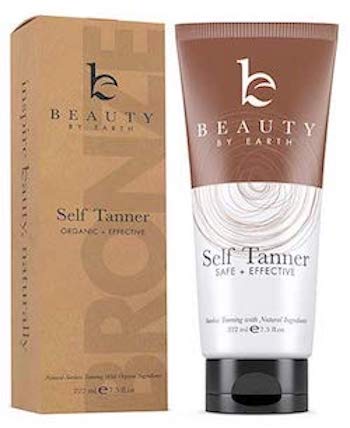Imagine being able to give yourself a permanent tan – never having to worry about spending time in the sun or self-tanning every second week at home.
It would be one of the most useful beauty products around and would be a hit with those who love having a gorgeous summer glow without the fuss of actually tanning.
But does a permanent self-tanner really exist?
Unfortunately, there is no such thing as a permanent self-tanner. There are some self-tanning products on the market, but they can only last for a maximum of a few weeks. Even tanning in the sun does not give you a permanent bronze tan.
There is no secret once-off miracle product that will keep you tanned for the rest of your life. The only way to maintain a tan is through reapplying self-tanner every few weeks or visiting the spray tan salon religiously.
Why Self-Tanning Isn’t Permanent
Self-tanners work by utilizing an ingredient called dihydroxyacetone (DHA). DHA is a sugar derived from sugar cane, and DHA has been used in the beauty industry for decades.
When the DHA is applied onto the skin, it interacts with the dead skin cells on the outer layer of the skin, and through a chemical reaction, it stains these skin cells darker. This darkening of the skin cells is what leaves you with a bronze tone.
However, the reason that the results are not permanent is due to your skin. Dead skin cells on the outer layer of the skin slough off, and with them goes the dark tan.
Most self-tanning products only last a week, and at a maximum two weeks without reapplication. Skin naturally sheds and replaces itself, just like every other organ in our body, the same way hair falls to make space for hair growth.
There are self-tanners that last a very long time. To learn which self-tanners last the longest, read this article I wrote: The Longest Lasting Self-Tanners
DHA is the only skin tanning agent that is approved by the FDA, so while this remains the only ingredient used to change the color of the skin, there will be no such thing as a permanent self-tanner.
In fact, looking at other tanning methods won’t offer you a permanent solution either. Tanning in the sun dries and damages your skin, and the same will happen to the tanned skin cells, they will eventually slough off and the tan would fade.
Spray tans are just the same, losing the bronze tone as dead skin cells are removed from the skin.
The Reason You Should Choose Self-Tanning
Self-tanners do not last as long as natural tans, those you get while sitting outside in the sun or in a tanning bed. However, self-tanners should be the first option when you are looking to build and maintain a healthy tan year-round.
If you read this blog often, you’ll know that our favorite self-tanner is Beauty by Earth. We can’t recommend it enough!
With the growth of the self-tanning industry, there are more and more products available which are organic and contain natural ingredients.
These help to nourish and hydrate the skin while self-tanning, giving it extra care and a very important summer radiance. DHA does not photo-age the skin or cause an increased risk of skin cancer.
A tan from the sun might fade, but the damage is done to the skin from the sun remains. UV rays break down the DNA in skin cells and can cause all types of problems, with skin cancer being a result of overexposure to the sun.
Self-tanners are safe, they do not pose a threat of lasting damage to the skin. The only time a problem might arise is if your skin has an allergic reaction to any of the ingredients in a self-tanning product.
The best way to check for this is to do a patch test 24 hours before the full application to see if your skin becomes irritated or inflamed. If there is no allergic reaction, it is safe to carry on with the application the next day.
Another reason that self-tanners should be your first choice for tanning is that they are much more controllable than the sun. With gradual self-tanners, you are able to slowly tan your skin until you reach your desired shade, from where you can maintain that shade by reapplying the self-tanner every few days.
You also don’t have to wait for a sunny day to tan, you can tan anytime and anywhere, all you need is your self-tanning product, some free space and a tanning mitt to help with the application.
How To Make Your Self-Tan Last Longer
You might not be able to ever enjoy a permanent self-tan, but that does not mean there aren’t ways to extend the life of your self-tan. Following these simple steps and tips, you should be able to have a self-tanner that lasts longer than most.
Preparation of Your Skin
Proper preparation of your skin before a self-tan application is so important to create the perfect canvas for a long-lasting tan.
4 days before – Moisturize your skin daily in the days leading up to the self-tan application. Exfoliate your skin regularly as well to make sure any old tan fades. Focus on moisturizing the drier areas of your skin, such as the ankles, knees, elbows, and hands. This helps the self-tan blend in easier in these areas.
1 day before – Wax or shave the day before self-tanning. Any hairs on the skin might act as a barrier to the self-tanning product and cause the tan to be patchy. It is also advised to do a patch test the day before to see that the resultant tan is the right shade for your skin tone and to watch for any allergic reactions.
Just before – Splash cold water onto your face just before applying the self-tanner. This closes the pores to stop the product from seeping too far into the skin, which could clog up pores and cause a breakout. Rub barrier cream into your hairline to avoid an awkward tan line.
The Application
The application of a self-tanning product does not need to be as daunting as it seems. Having the right tools and techniques is all you need to achieve a flawless-looking tan.
The tools – A tanning mitt is a definite must when self-tanning at home. It helps to properly blend in the product and stops your hands from staining too dark.
Application – Apply the self-tanning products in small amounts, working your way from the bottom up. This is to avoid you bending over to apply the product to your feet when the product on your stomach is still wet, which can leave streaks and tan-free areas.
The product – Gradual self-tanners are always a good idea for those looking for a long-lasting, natural-looking tan. You will need to apply this regularly, but it helps to slowly develop a bronze tone on the body without going from pale to shocking bronze in one application.
Making The Tan Last
Moisturize – Moisturizing regularly after self-tanning is the best way to ensure your tan lasts for longer. Hydrated skin will not slough off as quickly as dry skin, keeping the tan lasting for longer.
Maintenance – If you do not want to do a full-body reapplication, you can mix some of your self-tanning product into your daily moisturizer to give your skin an extra glow and to revive any fading pigmentation.
Protection – Use a waterproof SPF sunscreen when outdoors to protect your skin and the tan from the sun and water.
Related Questions
How long will a self-tan last?
Most self-tanning products only give the skin a tan for around 5 to 10 days. The lighter the tan, the shorter it will last, with darker tans generally reaching around 10 days in lifespan.
How long the tan lasts will also depend on the condition of the skin, the application and the maintenance of the tan.
Can I apply self-tan over an existing self-tan?
It is not a good idea to apply a new self-tan over an existing self-tan. A new self-tanning product placed over a fading tan will only highlight the breakup of the older tan color. Before applying the product, exfoliate to remove the old tan from the skin. A fresh, clean slate is best for a self-tanner to really shine.
Can you tan through a self-tan?
Some self-tanning products come with a built-in SPF. However, it is usually not strong and will not last very long. You are still able to tan through a self-tan, and you should have a fairly even result.
In some cases, the self-tanning product may act as a barrier to the UV rays and the tan might be slightly patchy. It is also important to remember that tanning in the sun will help to fade a self-tan quicker.
Permanent Self-Tanner – A Myth
There is no such thing as a permanent self-tanner, and this is all thanks to our skin constantly replacing skin cells with new ones, and the tan fading away as skin cells slough off.
While it might be frustrating having to apply self-tanner every couple of weeks, it is for the best. We would much rather having continuously healthy skin than a build-up of skin cells throughout life.
Remember to tan and maintain your tan as safely as possible. Self-tanners are your best bet to avoid any permanent damage to your skin, and are really easy to use at home!

